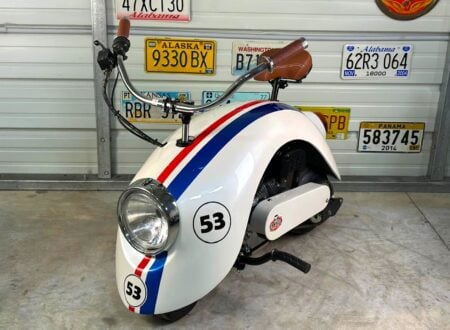The Honda Motocompo was unveiled in 1981 as a mini folding scooter that was designed to fit neatly into the trunk of your car. In fact the trunk of the Honda City compact car was specifically designed to accommodate the Motocompo in its folded down configuration.
Although there were many folding scooter designs that came before the Honda Motocompo, the Motocompo was the first to have been invented to accompany a specific car. The premise being that you could drive your car to the outskirts of a city, park it, climb into your scooter and use that for navigating in town.
Fast Facts – The Honda Motocompo
- The Honda Motocompo was sold between 1981 and 1983. Despite its relatively short production run it’s become a cult classic, and surviving examples are now highly sought after.
- Power is provided by a 49cc air-cooled two-stroke engine with a single cylinder producing 2.5 hp at 5,000 rpm.
- Total weight is 45 kgs or 99 lbs, so you can’t skip weights day at the gym if you plan to regularly lift it in and out of your trunk.
- A total of just over 53,000 Honda Motocompos were built during production, so they’re still relatively affordable when they come up for sale, with prices typically around the $3,000 to $5,000 USD mark.
A New Kind Of Folding Scooter
When the Motocompo was released in 1981 folding scooters are nothing new, one of the earliest examples was the British Welbike. It was a folding scooter invented during WWII that could be slid into a cylinder and parachute dropped into occupied Europe to provide transport for troops.
Above Video: English Ska band “Madness” were hired to create a music video for the Honda Motocompo in 1981 in order to help promote the bike.
A surprising number of folding motor scooters have been marketed over the years, dating all the way back to the First World War, however none have come closer to rivaling the popularity of the quintessentially Japanese Motocompo.
The 1980s were a time when designers around the world were questioning the nature of modern mobility, it was a decade that saw the appearance of the Sinclair C5 and the Motocompo on one hand, and the Ferrari F40 and Porsche 959 on the other.
Honda’s intention with the Motocompo was to offer it for sale either as a package with the Honda City compact car, or on its own for those who just wanted a scooter they could fit in their trunk.
As mentioned above, the plan was to offer a new two-tier mobility system for people in Japan and in other urban environments around the world. People could drive their car to near where they wanted to go, then ride the rest of the way on the scooter – bypassing traffic jams and enjoying vastly simplified parking.
Honda had initially estimated that they would sell upwards of 10,000 Motocompos and 8,000 Honda Cities each month however actual Motocompo production fell well short of this. By the end of production in 1983 53,000 had been sold, working out to approximately 1,500 per month on average.


The retro-80s design combined with the inherent usefulness of the Motocompo has led to the little scooter becoming a bonafide cult classic in recent years, and they’re always wildly popular the they appear at shows like Radwood.
The Honda Motocompo Shown Here
The Motocompo shown here is a 1982 model from the middle of the production run and it is finished in Shetland White.
With the handlebars, seat, and foot pegs folded in it measures in at 1,185 mm x 240 mm x 540 mm which works out to 46.7 in × 9.4 in × 21.3 in. The top speed is somewhere between 30 and 50 km/h depending on the weight of the rider, however sustained speeds above 30 km/h are generally discouraged.
This Motocompo has never been recommissioned and it presents in good original condition throughout. Bidding with Bonhams is due to close on the 29th of November, and bids are now being taken live online.
If you’d like to read more about it or register to bid you can click here to visit the listing.








Images courtesy of Bonhams








